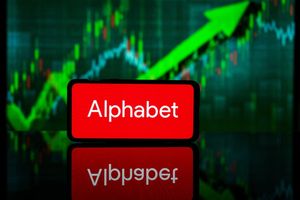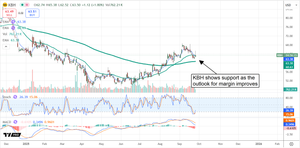
The U.S. financial markets are grappling with a perplexing divergence as Treasury yields climb, signaling falling bond prices, even as the Federal Reserve has initiated interest rate cuts to navigate a moderating labor market. This counterintuitive movement on September 25, 2025, comes against a backdrop of robust second-quarter GDP growth but persistent inflation and an increasingly cautious Fed. The immediate implication is a tightening of financial conditions for businesses and consumers, threatening to undermine the economy's resilience and complicate the central bank's delicate balancing act.
This unexpected rise in longer-term borrowing costs, despite the Fed's recent dovish pivot, suggests that market forces, perhaps driven by renewed inflation expectations or concerns over government debt, are overriding central bank efforts to ease credit. The scenario presents a critical challenge for investors, policymakers, and corporations alike, as higher yields translate to increased government borrowing costs, more expensive corporate and consumer loans, and potential pressure on equity valuations, particularly for growth-oriented companies.
Treasury Turmoil: A Deep Dive into Rising Yields and Market Reactions
On September 25, 2025, the U.S. Treasury market experienced a notable sell-off, with yields across the curve generally rising. The benchmark U.S. 10-Year Note Bond saw its yield increase to approximately 4.16% to 4.18%, a significant move that reflects a decrease in bond prices. This upward trend in yields occurred despite the Federal Reserve's recent decision to cut the federal funds rate by 25 basis points earlier in September, bringing it to a range of 4.00%-4.25%. This marked the first rate reduction since December 2024, intended to address a softening labor market.
The timeline leading up to this moment reveals a complex economic narrative. Throughout late 2024 and early 2025, the Federal Reserve maintained a hawkish stance to combat stubbornly high inflation, keeping interest rates elevated. However, as 2025 progressed, economic data began to show a mixed picture. While the second quarter of 2025 saw robust real GDP growth of 3.8% annually, signaling underlying economic strength, the labor market started to cool. Job creation weakened, and the unemployment rate rose to 4.3% in August 2025, its highest since 2021, with payroll growth falling below 100,000 for four consecutive months. Inflation, though declining from its peak, remained above the Fed's 2% target at 2.9% in August, partly due to tariff-related price increases. This confluence of factors prompted the Fed to pivot, cutting rates to balance inflation control with support for employment.
Key players involved in this dynamic include the Federal Reserve, whose monetary policy decisions directly influence short-term rates; the U.S. Treasury Department, which issues government debt; and a vast array of institutional investors (e.g., pension funds, mutual funds, foreign central banks) who are major buyers and sellers of Treasuries. Initial market reactions to the rising yields have been cautious. Equity markets, while initially supported by the prospect of a strong economy, are now facing headwinds as higher bond yields make fixed-income investments more attractive and increase discount rates for valuing future earnings. The U.S. Dollar (USD) has also seen some strength as higher yields attract foreign capital.
The divergence—a Fed cutting rates while longer-term Treasury yields rise—suggests that market participants may be pricing in different expectations than the central bank. This could stem from concerns about persistent inflationary pressures, the sheer volume of government debt issuance, or perhaps a belief that the economy's underlying strength could reignite inflation despite the labor market's moderation. This skepticism complicates the Fed's path forward, making its goal of a "soft landing" increasingly challenging.
Corporate Crossroads: Winners and Losers in a Higher Yield Environment
The landscape of falling Treasuries, translating to higher borrowing costs, will inevitably create a distinct set of winners and losers across various public companies and sectors. Companies with strong balance sheets, ample cash reserves, and less reliance on external financing will be better positioned to weather the storm, while those heavily indebted or dependent on frequent refinancing will face significant headwinds.
Financial institutions, particularly large banks like JPMorgan Chase (NYSE: JPM), Bank of America (NYSE: BAC), and Wells Fargo (NYSE: WFC), could see mixed effects. While higher interest rates generally boost net interest margins, the rising cost of funding for their own operations and the potential for increased loan defaults in a slowing economy could offset these gains. Mortgage lenders, however, are likely to face reduced demand as higher Treasury yields push up mortgage rates, making homeownership more expensive and potentially cooling the housing market.
On the losing side, highly leveraged companies across all sectors will feel the pinch of increased borrowing costs. This includes many growth technology companies that often rely on debt to fund expansion, such as Tesla (NASDAQ: TSLA) or emerging biotech firms. Their future earnings, already discounted more heavily in a higher interest rate environment, become even less attractive when the cost of capital rises. Similarly, real estate investment trusts (REITs) and developers could struggle as property values come under pressure from higher cap rates and financing for new projects becomes more expensive. Companies with substantial variable-rate debt will see an immediate increase in their interest expenses, directly impacting their profitability.
Conversely, companies with robust free cash flow and minimal debt, particularly in defensive sectors like consumer staples (e.g., Procter & Gamble (NYSE: PG)) or utilities (e.g., NextEra Energy (NYSE: NEE)), tend to be more resilient. Their stable earnings and ability to self-finance make them attractive to investors seeking safety in a volatile market. Additionally, certain value-oriented companies with strong dividend yields might become more appealing as their payouts become competitive with rising bond yields, attracting income-focused investors. The energy sector, with companies like ExxonMobil (NYSE: XOM), could also be relatively insulated if commodity prices remain firm, providing strong cash flows independent of borrowing costs.
Wider Significance: Unpacking the Macroeconomic Ripple Effects
The phenomenon of rising Treasury yields amidst a strong economy and a Fed rate-cutting cycle carries profound wider significance, signaling potential shifts in broader industry trends and economic stability. This divergence suggests a market that is either anticipating renewed inflationary pressures, expressing concern over the growing U.S. national debt, or reacting to a global repricing of risk. It complicates the narrative of a smooth economic "soft landing" that the Federal Reserve aims to achieve.
The potential ripple effects are extensive. For competitors and partners, higher borrowing costs can create an uneven playing field. Smaller, less established companies may find it harder to secure affordable financing, potentially leading to consolidation within industries as larger, better-capitalized firms acquire distressed assets. Supply chains could also face pressure, as suppliers reliant on short-term credit struggle to manage inventory and operations. Globally, if U.S. Treasury yields continue to rise, it could attract capital away from emerging markets, potentially destabilizing their currencies and financial systems.
Regulatory and policy implications are also significant. The U.S. Treasury will face increased pressure to manage the national debt more effectively, possibly prompting debates over fiscal austerity measures or alternative financing strategies. The Federal Reserve's credibility could be tested if its rate cuts fail to translate into lower long-term borrowing costs, forcing it to reassess its communication strategy and policy tools. Lawmakers might also face renewed calls for fiscal discipline to alleviate market concerns about government solvency.
Historically, periods of rising bond yields in a strong economy have often preceded economic slowdowns or recessions, as the increased cost of capital eventually stifles investment and consumer spending. For instance, the tightening cycles in the late 1990s or mid-2000s, while different in their specific triggers, demonstrated how higher long-term rates can act as a brake on economic expansion. The current situation, however, is unique due to the concurrent Fed rate cuts, suggesting that market forces are exerting an independent influence, possibly reflecting a deeper concern about structural inflation or fiscal sustainability that transcends short-term monetary policy. This makes historical comparisons valuable but not perfectly analogous, highlighting the complexity of the current environment.
What Comes Next: Navigating the Evolving Economic Landscape
The path forward for the U.S. economy and financial markets, given the current paradoxical environment of rising Treasury yields amid a strong economy and Fed rate cuts, is fraught with both challenges and opportunities. In the short term, market volatility is likely to persist as investors attempt to reconcile the conflicting signals from economic data and monetary policy. Companies and consumers will face higher borrowing costs, which could temper enthusiasm for new investments and large purchases, potentially leading to a deceleration in economic growth in late 2025 and early 2026. The Federal Reserve will be under intense scrutiny, with every public statement and data release meticulously analyzed for clues on its next move, especially if rising long-term yields negate the intended easing effects of its rate cuts.
In the long term, this scenario could force significant strategic pivots. Businesses may need to prioritize debt reduction and cash flow generation over aggressive expansion, focusing on efficiency and organic growth. Industries heavily reliant on leverage, such as private equity and real estate, might see a structural shift towards more conservative financing models. Market opportunities could emerge for investors in sectors that are less sensitive to interest rates, such as defensive stocks, or in companies with strong competitive moats and pricing power that can pass on higher costs to consumers. Conversely, challenges will arise for highly indebted companies and those operating in capital-intensive industries, which may struggle to adapt to a persistently higher cost of capital.
Potential scenarios and outcomes range from a "hard landing," where the rising yields combine with the cooling labor market to tip the economy into a recession, to a "muddle-through" scenario, where growth slows but avoids a deep downturn. Another possibility is that the market's concerns about inflation or debt subside, leading to a stabilization or even a decline in long-term yields, allowing the Fed's rate cuts to have their full intended effect. However, the current divergence suggests a more complex equilibrium where market forces are asserting their independence from central bank policy, making a smooth resolution less certain. Investors should prepare for continued uncertainty and a market environment that rewards agility and careful risk management.
Comprehensive Wrap-Up: Key Takeaways and Future Watchpoints
The current financial landscape, marked by falling Treasuries (rising yields) despite a Federal Reserve rate cut in a seemingly strong economy, presents a multifaceted challenge for market participants. The key takeaway is the emergence of a significant divergence: while the Fed aims to ease financial conditions to support a softening labor market, longer-term market rates are moving in the opposite direction. This suggests that market forces are either anticipating persistent inflation, reacting to substantial government debt issuance, or expressing skepticism about the economy's true resilience. The immediate consequence is higher borrowing costs for the government, businesses, and consumers, which could act as a drag on future economic growth.
Moving forward, the market will likely be characterized by continued volatility and a re-evaluation of asset classes. Investors should assess their portfolios for exposure to interest-rate-sensitive sectors and highly leveraged companies. The resilience of corporate earnings will be tested as financing costs rise, potentially leading to a widening gap between companies with robust balance sheets and those with precarious debt loads. The housing market, in particular, will bear watching, as higher mortgage rates could further cool demand and impact consumer spending.
Final thoughts on the significance and lasting impact point to a potential paradigm shift where the cost of capital remains elevated compared to the ultra-low rates of the past decade, even if the Federal Reserve continues to cut short-term rates. This could usher in an era of more disciplined corporate finance and a greater emphasis on profitability over growth at all costs. What investors should watch for in the coming months includes further inflation data, the Federal Reserve's subsequent policy decisions and forward guidance, and, critically, the U.S. Treasury's borrowing plans. The interplay between these factors will determine whether the economy can navigate this complex environment towards a sustainable path of growth or succumb to the pressures of higher long-term rates.
This content is intended for informational purposes only and is not financial advice





